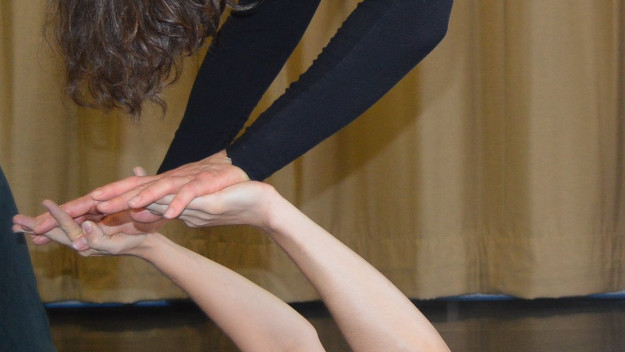A friend ask me if it was possible to teach contact improvisation. Good question – it’s improvised after-all!
Perhaps when I’m teaching my next dance class, I shall start it by asking that people touch each other on the arm. Most – if not all of them I expect – will use their hand to come into contact with the arm of the other person. Yet any part of the body could be used to give touch.
It’s natural we’d do this – touch the arm with a hand. Simply stated – we are hand centred creatures, and creatures of habit too! Hands are both fantastic articulators and also packed with sensors to give all sorts of tactical feedback. But our hands – especially if we only consider the palm-side – are perhaps about 3% of the surface of our skin? Overcoming our hand-centeredness is one of the tasks of teaching contact improvisation.
Equally though, starting with people’s natural approach to contact – thought the hands – is a comfortable place from which to overcome feelings of apprehension at touching someone else.

I used to introduce contact improvisation by saying this:
When my gran asked me what was contact improvisation then I put my hands up and I asked her to do the same so that our palms were in touching. Then I said to her: now, keep your hands in contact with mine and let’s dance together! Now you [students] try it!
Permissible and possible

What we’re learning in contact improvisation is maybe two fold: firstly, what we can do – that is [social] permissibility; and secondly how to improvise – what we could do – [physical] possibility!
Overcoming habitualised practices in contact and movement practice reveals these possibilities and enhances our creative potential.
Differing contexts set different expectations and practices in terms of intimate physical contact and movement practice: playing sport, going to a meeting, being with members of our family – the differing contexts bring different expectation of close and intimate physical contact. When we teach contact improvisation we are creating an environment for this too: a context for it.
While contact improvisation may be improvised, there is a body of movement practice which constitutes contact improvisation. Simply by visiting different communities for contact improvisation we see similarities in their practice. This is partly because there are teachers who teach and re-teach similar techniques and practices in different times/places i.e cultural reproduction and enforcement. But also, there is also a tendency for a community of dancers to coalesce around a dance form: they become vestigial stores of cultural practice. If new entrants don’t like the practice then they select out and don’t return (which I also described previously).
Where to connect

At the end of this month [April], I attended a class for Argentine tango at Oxford University Tango Society which was about the embrace: how we embrace each other in tango. The connection with a dance partner in tango is at the sternum in the chest and, as the teacher said – we are dancing a walked hug.
As an illustration of how not to connect, we walked with a partner but touching at our bellies – the place we call our centre in contact improvisation. Then we repeated the exercise with our sternum – pressing our chests together as we walked. This latter method is correct in Argentine tango but not the former. Feel the difference!
Partly, the rather formalised way of holding our partners hands and back in tango does make the belly-to-belly dance clumsy. In contact improvisation there is more freedom to adjust and re-adjust and indeed to improvise. It’s less rigid.
Kinosphere
Video: Dancing Contact Improvisation. Steve Paxton, Nancy Stark-Smith in a clip from the film “Fall After Newton”, 1987
It’s said that contact improvisation is a dance of the centres because we are not always on our feet, walking, as in tango. We could be inverted – standing on our hands (handstand), balancing on our partner, supporting them on ourselves, moving to them or away from them, and falling with them too.
In contact, we think in terms of a kinosphere – the points of contact which we could reach – all around us, thus creating the surface of a sphere: spherical space. At the centre of that sphere is a centre, and it is our centre: the place two finger-widths below our belly button. When we connect with our dance partner here then it is the greatest intersection of the two spheres. Notice that it is not at our periphery – which we find when we reach out and touch around us with our limbs – especially our hands.
Thus we often start teaching contact improvisation at the edge of these two kinospheres – using our hands to reach out and touch. But is it too much to simply start at the centre, I wonder?
Notes
Featured image at top of page: dancing at Oxford Contact Dance in September 2014.
